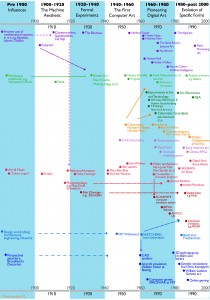- Why use the term ‘Computer Art’?
- Metaphors as a basis for understanding technology
- Limitations of the term ‘computer art’
- Previous attempts to define Computer Art
- Definitions based on procedure
- The computer’s role in fine art
- Distinguishing “art” from “graphics” part 1 and part 2
- A functional difference between ‘art’ and ‘graphics’
The Development of Computer Art
- The interrelation of Computer Graphics and Computer Art
- The Progress of Computer Graphics technology
- Was ‘Computer Art’ an inevitable development?
- Linking historic Computer Art to previous artforms
- Abstract Animation
- Mathematics and systems in art
- Ben Laposky’s Oscillons
- John Whitney’s use of analogue computers
- Use of analogue computers in other contexts
- The influence of Constructivism and the Bauhaus
- The Last Stance of Abstract Art?
- The Influence of Kinetic Art
- Art and technology in the 1960s: the broader context
- Expectations of Computer Art in the 1960s
- The Perception and Reception of Computer Art
- Conclusion to Historical Section
The Computer as a Platform for Art
- The computer as medium
- The digital space
- The material traces of Computer Art
- The position of the ‘original’ in Computer Art
- Applying Nelson Goodman’s theories to Computer Art
- Problems with Goodman: Lydia Goehr etc
- Physical Computer Art – a contradiction?
- Notation and Performance
- The “work” of Computer Art
- Case study: Harold Cohen and AARON
- The physical trace as a record of artistic process
- The status of Computer Art as a musical “work”
Artistic Approaches to the Computer
- Does the status of ‘Computer Art’ depend on its production?
- Factors in the Computer’s Artistic Usage
- Computer Art and craft
- Gibson’s tool functions applied to the computer
- The act of using the GUI
- Metaphors connecting the GUI with older media
- Case study: Catherine McIntyre
- Conceptual frameworks imposed by GUI and the artist
- Non-linear elements and the concept of risk
- Alternative approaches to real-time image manipulation
- Specialised vs. standardised interfaces
- Drawbacks with the GUI
- The historic importance of artist-programmers
- Case study: William Latham’s pre-Computer Art and his computer artworks
- Algorism and the Algorists
- Jean-Pierre Hébert’s physicalised Computer Art
- Hébert’s aesthetic
- Drawbacks of programming to create digital art
- Section conclusion
Bibliography
- Manuscript and Archival Sources
- Printed Primary Sources
- Printed Secondary Sources
- Unpublished papers, theses and interviews
- Web References


